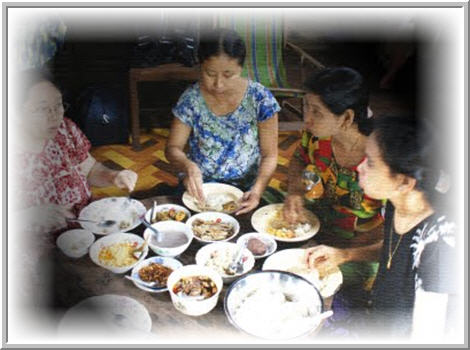India And Myanmar Celebrate Shared Heritage Through Food

Table of Contents
Historical Connections: The Roots of Shared Culinary Traditions
The culinary kinship between India and Myanmar is deeply rooted in their historical and cultural exchange. Centuries of trade along ancient routes, significant migration patterns, and the spread of Buddhism have all contributed to the fusion of flavors and techniques we see today. The impact of these exchanges on their respective cuisines is undeniable, creating a unique culinary landscape.
The Influence of Indian Spices and Ingredients
Burmese cuisine is vibrant with the warm embrace of Indian spices. Turmeric, chili, cumin, and coriander, staples in Indian cooking, have become integral parts of many Burmese dishes. This isn't just about adding flavor; it's about incorporating a core element of Indian culinary identity into Burmese gastronomy.
-
Burmese dishes with significant Indian spice influence:
- Mohinga: This iconic Burmese fish noodle soup often incorporates turmeric, lemongrass, and chili, all commonly found in Indian cooking.
- Ohno Khauk Swe: This coconut milk-based noodle curry features a blend of spices reminiscent of South Indian curries.
-
Specific Indian spices and their role in Burmese cooking:
- Turmeric: Provides color and a slightly bitter, earthy flavor.
- Chili: Adds heat and depth to many dishes.
- Cumin: Contributes a warm, earthy aroma.
- Coriander: Offers a citrusy, fresh note.
The Spread of Indian Cooking Techniques
Beyond spices, Indian cooking techniques have also significantly shaped Burmese culinary practices. Methods like curries, frying, and grilling, hallmarks of Indian cuisine, are readily apparent in Burmese dishes. This shared understanding of cooking techniques further strengthens the culinary connection.
-
Burmese dishes showcasing Indian cooking techniques:
- Many Burmese curries utilize the same slow-simmering techniques found in Indian curries.
- Deep-frying, a common method in both cuisines, is used to prepare various snacks and appetizers.
-
Comparative analysis of similar dishes in both cuisines:
- Comparing Burmese and South Indian vegetable curries reveals striking similarities in the use of coconut milk, spices, and vegetables.
Key Dishes Reflecting Shared Heritage
Several dishes explicitly demonstrate the interwoven culinary histories of India and Myanmar. These culinary connections extend beyond popular dishes to encompass lesser-known regional specialties, creating a diverse and delicious representation of this shared heritage.
Mohinga: A Burmese Dish with Indian Roots?
Mohinga, the national dish of Myanmar, is a prime example of potential Indian influence. While its origins are debated, the use of spices and the overall cooking method strongly suggest Indian culinary influences.
-
Specific ingredients in Mohinga and their possible Indian origin:
- The use of turmeric and chili peppers points to a clear Indian connection.
- The fish-based broth shares similarities with certain South Indian fish curries.
-
Comparison with similar Indian dishes:
- Mohinga's complex spice blend and creamy texture are reminiscent of various South Indian fish curries.
Other Shared Dishes and Culinary Similarities
Beyond Mohinga, numerous other dishes and culinary practices highlight the shared heritage. This includes a variety of vegetarian options and regional variations that further showcase the depth of this culinary relationship.
-
List of Burmese dishes with apparent Indian influence:
- Various Burmese curries (e.g., chicken curry, vegetable curry)
- Tea leaf salad (Lahpet Thoke), which features fermented tea leaves and often includes spices like peanuts and fried beans.
- Many Burmese snacks and sweets incorporate similar techniques and ingredients found in Indian counterparts.
-
Mention regional variations within both Indian and Burmese cuisines: The diversity within both Indian and Burmese cuisines is vast, reflecting regional preferences and unique ingredients. This further enriches the shared culinary experience.
Modern Interpretations and Fusion Cuisine
The shared culinary traditions continue to evolve in modern times, with innovative chefs blending traditional techniques and flavors to create exciting new dishes. This demonstrates the enduring influence of Indian cuisine on Burmese food and shows the vibrancy of this culinary heritage.
Fusion Restaurants and Innovative Dishes
Modern restaurants are embracing the fusion of Indian and Burmese flavors, leading to inventive dishes that showcase the best of both worlds. This culinary experimentation creates exciting new gastronomic experiences.
-
Examples of fusion restaurants and innovative dishes:
- Restaurants incorporating Indian spices into Burmese-style noodle soups.
- Dishes combining Indian bread with Burmese curries.
-
Discussion on the creativity and innovation in combining both cuisines: The combination of vibrant Burmese flavors with the depth of Indian spices has resulted in exciting, flavorful and unique culinary creations.
The Future of Shared Culinary Heritage
The future holds exciting possibilities for further collaboration and exchange between Indian and Burmese chefs and food enthusiasts. This shared culinary heritage is a testament to the enduring relationship between the two countries.
- Opportunities for culinary collaborations and cultural exchange: Joint cooking classes, food festivals, and chef exchanges can further promote understanding and appreciation of this shared heritage.
- The role of tourism and food festivals in promoting shared heritage: Tourism can play a vital role in promoting these culinary traditions by exposing a wider audience to the unique flavors and culinary history shared between India and Myanmar.
Conclusion: A Culinary Journey Through Shared Heritage
The culinary connections between India and Myanmar are a testament to their deep and enduring shared history. From the use of common spices and cooking techniques to the striking similarities in key dishes, the influence is undeniable. This gastronomic exploration underscores the rich tapestry of flavors and traditions woven together through centuries of cultural exchange.
Embark on your own culinary journey and discover the fascinating shared heritage of India and Myanmar through their food! Visit restaurants offering these delicious cuisines, or try cooking some of the dishes mentioned above. Explore the vibrant world of Indian and Burmese cuisine, and savor the rich flavors that reflect their intertwined past. Your gastronomic exploration awaits!

Featured Posts
-
 Den Of Thieves 2 Your Guide To Streaming Options This Week
May 13, 2025
Den Of Thieves 2 Your Guide To Streaming Options This Week
May 13, 2025 -
 Mind Blowing Experiences Discover The Extraordinary
May 13, 2025
Mind Blowing Experiences Discover The Extraordinary
May 13, 2025 -
 Ac Milan Vs Atalanta Prediksi Skor Akurat Head To Head Dan Starting Xi
May 13, 2025
Ac Milan Vs Atalanta Prediksi Skor Akurat Head To Head Dan Starting Xi
May 13, 2025 -
 Prediksi Skor Atalanta Vs Venezia Susunan Pemain Statistik And Head To Head Serie A Liga Italia
May 13, 2025
Prediksi Skor Atalanta Vs Venezia Susunan Pemain Statistik And Head To Head Serie A Liga Italia
May 13, 2025 -
 Experiences That Will Blow Your Mind Unforgettable Adventures
May 13, 2025
Experiences That Will Blow Your Mind Unforgettable Adventures
May 13, 2025
